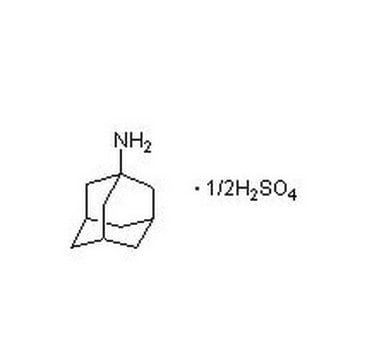A1260
1-Adamantylamin -hydrochlorid
≥98% (TLC), powder, NMDA receptor antagonist
Synonym(e):
1-Amino-adamantan -hydrochlorid, Amantadin -hydrochlorid, NSC 83653, Tricyclo[3.3.1.13,7]decan-1-amin -hydrochlorid
About This Item
Empfohlene Produkte
product name
1-Adamantylamin -hydrochlorid,
Form
powder
Löslichkeit
H2O: 50 mg/mL
ethanol: soluble
Ersteller
Endo
SMILES String
Cl[H].[H][C@@]12C[C@@]3([H])C[C@@]([H])(C1)CC(N)(C2)C3
InChI
1S/C10H17N.ClH/c11-10-4-7-1-8(5-10)3-9(2-7)6-10;/h7-9H,1-6,11H2;1H/t7-,8+,9-,10-;
InChIKey
WOLHOYHSEKDWQH-SOVZANNPSA-N
Suchen Sie nach ähnlichen Produkten? Aufrufen Leitfaden zum Produktvergleich
Allgemeine Beschreibung
Anwendung
- to determine its effectiveness in reducing surgery-induced cognitive impairment
- to preincubate multipotent stem cells (MSCs), to investigate the cellular internalization pathway
- to determine whether amantadine-attenuated sepsis-induces neuroinflammation and dysfunction of learning and memory
- to preincubate primary cultured rat dental pulp stem cells (rDPSCs)
- to determine the pathway of internalization
Biochem./physiol. Wirkung
Leistungsmerkmale und Vorteile
Signalwort
Warning
H-Sätze
P-Sätze
Gefahreneinstufungen
Acute Tox. 4 Oral
Lagerklassenschlüssel
11 - Combustible Solids
WGK
WGK 3
Flammpunkt (°F)
Not applicable
Flammpunkt (°C)
Not applicable
Persönliche Schutzausrüstung
dust mask type N95 (US), Eyeshields, Gloves
Analysenzertifikate (COA)
Suchen Sie nach Analysenzertifikate (COA), indem Sie die Lot-/Chargennummer des Produkts eingeben. Lot- und Chargennummern sind auf dem Produktetikett hinter den Wörtern ‘Lot’ oder ‘Batch’ (Lot oder Charge) zu finden.
Besitzen Sie dieses Produkt bereits?
In der Dokumentenbibliothek finden Sie die Dokumentation zu den Produkten, die Sie kürzlich erworben haben.
Kunden haben sich ebenfalls angesehen
Artikel
Discover Bioactive Small Molecules for ADME/Tox
Unser Team von Wissenschaftlern verfügt über Erfahrung in allen Forschungsbereichen einschließlich Life Science, Materialwissenschaften, chemischer Synthese, Chromatographie, Analytik und vielen mehr..
Setzen Sie sich mit dem technischen Dienst in Verbindung.













